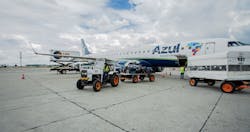Some 10 years ago the International Air Transport Association (IATA) introduced the ground damage database (GDDB) for the collection of aircraft ground damage reports, the determination of trends and the enabling of analysis.
Recently, the GDDB has been channelled into IATA’s Incident Data eXchange (IDX), which uses global and regional trend data analytics to set safety and security performance targets.
IDX is IATA’ safety and security incident data management program. IDX is a worldwide, aggregated, de-identified database of incident reports – including flight operations, cabin, ground operations safety and security occurrences. It offers a secure environment, providing participants with a seamless experience to view aggregated data against standards and benchmarked with other counterparts.
In IDX, IATA has brought together both ground and flight safety information in a more comprehensive and user-friendly format.
“Ground damage events represent a significant safety issue and cost challenge for the industry,” IATA officials explain. “Having a comprehensive database of such instances enables the identification of risk factors involved in ground damage events and benchmarking of best practices to avoid them.”
Safety and security information is shown in terms of key performance indicators. This is helping IDX participants to benchmark their own performance and establish safety performance targets in accordance with the International Civil Aviation Organization’s (ICAO) requirements for safety management systems (SMS).
“This platform offers a secure, robust environment and improved user management, providing operators and industry stakeholders a seamless experience to contribute data, track the quality of their data submissions and consume various relevant analytics – all through a single portal,” say IATA officials.
The contributors of IDX are airlines and ground service providers (GSPs) that participate to the database and consume IDX reports.
“Airlines and GSPs were participants of GDDB, and it is still the case also for IDX. Data contributions consist in the submission of ground damage reports, containing the relevant information of each event, and participants submit their data through the IATA One Identity customer portal, a secure environment for data sharing,” note IATA officials. “Data is consolidated as aggregated and de-identified information, and this level of aggregated data is shown through interactive dashboards that can be found in the same secure environment. Standard reports have also been distributed regularly to the industry to show the latest ground damage trends and hotspots.”
IDX is an element of IATA’s Global Aviation Data Management (GADM) program which is used to help identify and monitor emerging safety issues as part of IATA’s Six Point Safety Strategy.
“This is a comprehensive approach to identify organizational, operational and emerging safety issues. IDX has been established in close cooperation with the member airlines and Strategic Partners through the IATA Safety Group (SG) and the Safety, Flight and Ground Operations Advisory Council (SFGOAC). This strategy is predicated on the SMS principles and methodology of performance-based management and oversight,” says Ricardo Miguel, president of ABESATA, Brazil’s national entity representing the GSPs, which shares tasks and information on a daily basis with IATA Brazil and ABEAR, the Brazilian association of domestic airlines.
To date, there are some findings of IDX that are of interest to the aircraft ground handling industry.
“An effective GSP SMS greatly contributes to prevent aircraft damages and, when they occur, the severity is much different between those GSPs with SMS implemented and those without one,” says Miguel. “Also, cargo and baggage loading equipment continue to represent in more than 50 percent of damage reports those pieces of equipment that cause the damage.”
The latest trend found in 2019, highlights that the aircraft damage rate has been relatively stable since 2015, with damage rates found on arrival being higher than the damage rates actively reported by airlines and or personnel of GSPs.
“Additionally, GDDB data was used to perform a quantitative analysis on the safety performance of IATA Safety Audit for Ground Operations (ISAGO) registered operators and non-ISAGO registered operators,” say IATA officials. “With the integration of GDDB with the ISAGO registry, we were able to display specific metrics in which ISAGO membership was improving ground operations safety performance. A few examples were the reporting culture, the more robust damage inspection upon arrival and consistent implementation of operating procedures. This helped the ISAGO program to show objective and meaningful indicators.”
For IDX participants, it is possible to implement specific initiatives based on IDX findings.
“The IATA Safety Group, the Safety, Flight and Ground Operations Advisory Council and the Ground Operations Council continuously analyze this information and set strategies and objectives to improve ramp safety,” says Miguel. “As an example, for 2020-2022, the ground operations objectives include delays reduction, cost reduction per turn, safety improvements and damage and injury cost reduction, the reduction of environmental impact, the promotion of rational standards and the support to IATA products and services.”
Through IDX it is possible to identify some regional aircraft ground damage trends. For example, in the Latin America and Caribbean regions the amount of ‘reported’ aircraft damages are more than those "found."
“This was the only region where the number of damages reported was higher than the number of damages discovered during ground operations, which is a positive indicator,” point out IATA officials.
“IDX participation helps individual ground handling companies to improve safety performance as each participating organization have the possibility to use the IDX reports to compare it with their own information and with their similar organizations,” adds Miguel.
IDX participation has effect on safety decision making as each organization has the possibility to use this information as part of their safety risk management.
“In particular, IDX participation enables to collect and analyze safety data and information, determine the likelihood and consequences of accidents and incidents – risks assessment, determine potential mitigation to make unacceptable risks acceptable, develop reasoned arguments for safety actions to be considered by management; and take management decisions on what to do,” says Miguel. “Also, they can use this information to support their safety assurance activities, especially in the safety performance monitoring and measurement activities.”
The active participation in the IATA safety data sharing program can help airline and GSP organizations to identify issues that are experienced by the industry, that a single operator may have not experienced yet, allowing for early mitigation of specific risks.
“The benchmarking provided in IDX, with de-identified and aggregated data, allows contributors to perform this risk identification and implement consequent actionable insights,” say officials at IATA.
ABESATA is involved in several industry initiatives in Brazil to address aircraft ground damage issues.
“The IATA regional office and some local offices are engaging civil aviation authorities and airports to recognize the IATA Ground Operations Manual (IGOM) as an alternate means of compliance (AMC) and pushing for the ICAO Ground Handling Manual (Doc. 10121). GSPs and airlines are encouraged to promote with their Civil Aviation Authorities on this effort,” says Miguel.
Unfortunately, he adds, in Brazil, the National Civil Aviation Agency of Brazil (ANAC) has not emphasized this issue with GSPs, transferring this role to airlines or aerodrome operators.
The promotion to participate in the IDX database has been part of the ISAGO workshops delivered in Bogotá, Colombia, in September 2019 and in Atlanta, Ga., in February 2020.
“ABESATA, as a member of the ANAC Advisory Council, has constantly urged the civil aviation authority to include the aeronautical accidents and incidents prevention and investigation system in the GSPs’ inspection list,” concludes Miguel.
About the Author

Mario Pierobon
Dr. Mario Pierobon provides solutions in the areas of documentation, training and consulting to organizations operating in safety-sensitive industries. He has conducted a doctoral research project investigating aircraft ground handling safety. He may be reached at [email protected].
